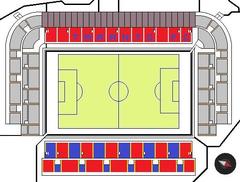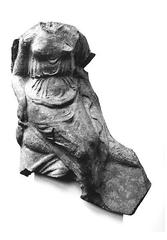Cloister of the San Domenico Convent, Taranto: Visiting Hours, Tickets, and Travel Guide
Date: 14/06/2025
Introduction
The Cloister of the San Domenico Convent in Taranto, Italy, is a living testament to the city’s millennia-spanning history. Built atop ancient Greek temple foundations, the convent reflects Taranto’s transformation from the Greek polis of Taras through medieval, Renaissance, and Baroque eras (Academia.edu, Core.ac.uk). Today, the site offers visitors a unique blend of archaeology, sacred architecture, and cultural heritage, positioning it as one of southern Italy’s most significant landmarks. This guide provides everything you need to plan your visit, including detailed historical context, practical information, travel tips, and recommendations for a rewarding experience.
Table of Contents
- Historical Overview
- Visitor Information
- Cloister and Archaeological Highlights
- Suggested Itineraries and Nearby Attractions
- Facilities and Services
- FAQs
- Visual Resources and Media
- Summary and Recommendations
- References
Historical Overview
Ancient and Medieval Foundations
The convent stands atop archaeological remains from the late 6th and early 5th centuries BCE, originally the site of a significant Greek temple. Archaeological excavations have revealed Neolithic artifacts, Greek temple foundations—including a peristyle and cella—and Roman architectural fragments (Core.ac.uk). During the Middle Ages, the site became a Benedictine abbey before passing to the Dominican order in 1510, marking the start of its enduring religious function.
Renaissance and Baroque Transformations
After its formal establishment by the Dominicans, the convent underwent significant architectural changes, especially following earthquakes in 1659 and 1783. Renaissance symmetry and classicism were blended with Baroque ornamentation. The cloister features arcaded walkways, carved capitals in carparo stone, and integrated Roman architraves—evidence of centuries of adaptive reuse (Academia.edu).
Cultural and Religious Significance
Throughout its history, the convent has served as a hub for theological study, community outreach, and cultural exchange. In modern times, after periods of expropriation and neglect, restoration efforts have transformed the complex into a museum and archaeological site, highlighting Taranto’s rich religious and urban history (Core.ac.uk).
Visitor Information
Opening Hours
- Tuesday to Sunday: 9:00 AM – 6:00 PM
- Closed: Mondays and major public holidays
It is recommended to check the official site or Taranto Tourism Board for seasonal updates.
Admission and Ticketing
- General Admission: €5
- Reduced: €3 (EU citizens aged 18-25)
- Free: Children under 18, Taranto residents
- Group and guided tours: Available upon request
Tickets are available at the entrance and online; Whichmuseum.com provides up-to-date information.
Accessibility
Most public and exhibition areas are on the ground floor, equipped with ramps and accessible restrooms. Some upper floors may require assistance. Advance notice is advised for visitors with mobility needs.
Guided Tours and Events
Guided tours are offered daily at 11:00 AM and 3:00 PM, with English-speaking guides available by reservation. Special exhibitions and workshops are scheduled throughout the year; consult the official website for current events.
Travel Tips
- Footwear: Wear comfortable shoes due to uneven surfaces.
- Photography: Permitted for personal use; flash and tripods may be restricted.
- Best times: Early morning or late afternoon for optimal lighting and fewer crowds.
How to Reach the Convent
The convent is located at Via Duomo, 33, 74123 Taranto, within the Old City (“Città Vecchia”). It is a 10-minute walk from Piazza Castello. Public buses and taxis serve the area; parking is limited.
Cloister and Archaeological Highlights
The cloister, with its arcaded walkways and central courtyard, is the heart of the convent. Surrounded by elegant 18th-century arches and leaf-capital columns, the cloister overlays a remarkable archaeological area containing Neolithic remains and the Greek temple’s foundations. Visitors can view the ancient structures through dedicated floor sections and interpretive panels. Faint frescoes and reused Roman elements enrich the architectural narrative.
Suggested Itineraries and Nearby Attractions
Combine your visit with other landmarks in Taranto’s Old Town:
- National Archaeological Museum (MARTA): Renowned for its Magna Graecia collections (MARTA)
- Aragonese Castle: Imposing medieval fortress
- Cathedral of San Cataldo: Apulian Romanesque architecture
- Greek Temple Ruins and Hypogea: Ancient urban layers
- Museo Diocesano di Taranto (Mu.di): Sacred art collections
Traditional eateries and cafés in the Old City offer authentic Apulian cuisine, completing the cultural experience.
Facilities and Services
- Restrooms: Available on site
- Audio guides: Multilingual, providing detailed interpretation
- No café on premises: Numerous dining options nearby
- Accommodation: Several hotels and B&Bs within walking distance, such as Hotel Akropolis and San Andrea degli Armeni B&B
Frequently Asked Questions (FAQ)
Are guided tours available?
Yes, in multiple languages by advance booking.
Is the cloister accessible for disabled visitors?
Ground floor areas are accessible; the upper floor may require assistance.
Are tickets available online?
Yes, especially during peak periods. Check Whichmuseum.com or the official site.
Can I take photos?
Personal photography is permitted; restrictions apply in certain areas.
Are there nearby sites to visit?
Yes, including MARTA, Aragonese Castle, Cathedral of San Cataldo, and more.
Visual Resources and Media
- High-resolution photographs of the cloister and archaeological features are available online.
- Interactive maps and virtual tours can be accessed via the official MARTA website.
- Map of San Domenico Convent Location (example link)
Summary and Recommendations
The Cloister of the San Domenico Convent is a portal into Taranto’s deep past, from Neolithic settlements to Greek, Roman, medieval, and Baroque layers. With accessible visitor services, reasonably priced admission, guided tours, and proximity to other major sites, it is an essential stop for anyone exploring southern Italy’s history and culture (Taranto Turismo, MARTA). Plan ahead, check for current opening hours and events, and consider booking tours to maximize your visit.
References
- Taranto The Convent Complex of San Domenico Maggiore: Redesigning and Museological Project, 2023, Academia.edu
- The San Domenico Convent in Taranto: History and Visitor Experience, 2024, Core.ac.uk
- Cloister of the San Domenico Convent Tickets and Visitor Information, 2024, Whichmuseum.com
- San Domenico Convent Official Site and Taranto Tourism Board, 2024, Taranto Turismo Board
- Museo Archeologico Nazionale di Taranto (MARTA), 2024
Experience the centuries-old heritage of Taranto at the Cloister of the San Domenico Convent—where history, spirituality, and architecture converge in a singular journey. For updates, events, and travel inspiration, download the Audiala app and follow us on social media.

